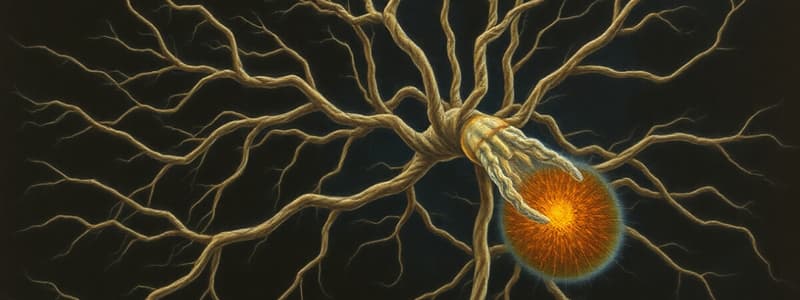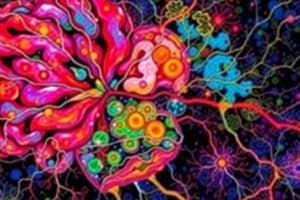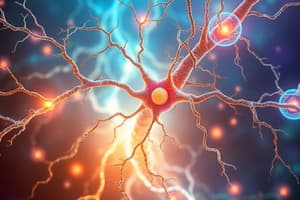Podcast
Questions and Answers
Which of these statements accurately describes the function of neuroglia?
Which of these statements accurately describes the function of neuroglia?
- Neuroglia act as support cells for neurons, maintaining homeostasis and protecting against pathogens. (correct)
- Neuroglia are the basic functional units of nervous tissue, responsible for communication.
- Neuroglia produce myelin, a fatty substance that insulates axons and speeds up nerve impulse transmission.
- Neuroglia transmit nerve impulses directly from one neuron to another.
What is the correct classification of a neuron with two processes, involved in sensory functions like vision and smell?
What is the correct classification of a neuron with two processes, involved in sensory functions like vision and smell?
- Unipolar neuron
- Multipolar neuron
- Interneuron
- Bipolar neuron (correct)
Which type of nerve carries impulses away from the CNS to muscles or glands?
Which type of nerve carries impulses away from the CNS to muscles or glands?
- Sensory nerve
- Mixed nerve
- Motor nerve (correct)
- Interneuron
What is the name of the connective tissue sheath that surrounds individual axons within a nerve?
What is the name of the connective tissue sheath that surrounds individual axons within a nerve?
Which of the following statements accurately describes interneurons?
Which of the following statements accurately describes interneurons?
Which of the following is NOT a characteristic of neurons in the Central Nervous System (CNS)?
Which of the following is NOT a characteristic of neurons in the Central Nervous System (CNS)?
A stroke occurs when:
A stroke occurs when:
Which of the following accurately describes the difference between nerves and tracts?
Which of the following accurately describes the difference between nerves and tracts?
Flashcards
Central Nervous System (CNS)
Central Nervous System (CNS)
Comprises the brain and spinal cord, responsible for interpreting sensory info and issuing commands.
Peripheral Nervous System (PNS)
Peripheral Nervous System (PNS)
Includes cranial and spinal nerves, conducting impulses to and from the CNS.
Neurons
Neurons
Basic functional units of nervous tissue that transmit messages as nerve impulses.
Neuroglia (Glial cells)
Neuroglia (Glial cells)
Signup and view all the flashcards
Types of Neurons
Types of Neurons
Signup and view all the flashcards
Interneurons
Interneurons
Signup and view all the flashcards
Sensory (Afferent) Nerves
Sensory (Afferent) Nerves
Signup and view all the flashcards
Stroke
Stroke
Signup and view all the flashcards
Study Notes
Structure of the Nervous System
- The nervous system is divided into the Central Nervous System (CNS) and the Peripheral Nervous System (PNS).
- The CNS includes the brain and spinal cord, responsible for interpreting sensory input and directing responses.
- The PNS incorporates cranial and spinal nerves, ganglia, and sensory receptors; it carries signals to and from the CNS.
Functions of Neurons and Neuroglia
- Neurons are the functional units of nervous tissue, transmitting nerve impulses.
- Neuroglia (glial cells) support neurons, act as phagocytes, and maintain homeostasis, protecting against pathogens.
- CNS neurons cannot regenerate or multiply, leading to lasting damage from injuries.
Types of Neurons
- Bipolar neurons: Two processes, involved in sensory functions like vision and smell.
- Unipolar neurons: Primarily sensory, carry information to the CNS in one direction from sensory receptors.
- Multipolar neurons: Most common type, involved in motor functions and complex processing; carry impulses from the CNS to muscles and glands.
- Interneurons: Located only in the CNS, connecting sensory and motor neurons. Crucial for reflexes and complex thought processes.
Structure and Function of Nerves
- Nerves are bundles of axons. In the CNS, these are called tracts; in the PNS, they are called nerves.
- Fascicles: Bundles of nerve fibers within a nerve, surrounded by connective tissue layers.
- Endoneurium: Surrounds each individual axon.
- Perineurium: Surrounds a fascicle of axons.
- Epineurium: The outermost layer surrounding the entire nerve.
Types of Nerves
- Sensory (Afferent) nerves: Conduct impulses from sensory receptors to the CNS.
- Motor (Efferent) nerves: Carry impulses from the CNS to muscles or glands.
- Mixed nerves: Contain both sensory and motor fibers; most peripheral nerves, including spinal nerves, are mixed.
Pathophysiology of the Nervous System
- Stroke: Results from a blood clot disrupting brain blood flow, damaging neurons and the blood-brain barrier. High stroke death rates are linked to the critical roles of affected brain regions.
- Myelin and nerve impulse transmission: Myelin is an insulating layer around axons; it speeds up nerve impulse transmission. Myelinated neurons transmit signals faster than unmyelinated neurons.
Studying That Suits You
Use AI to generate personalized quizzes and flashcards to suit your learning preferences.




